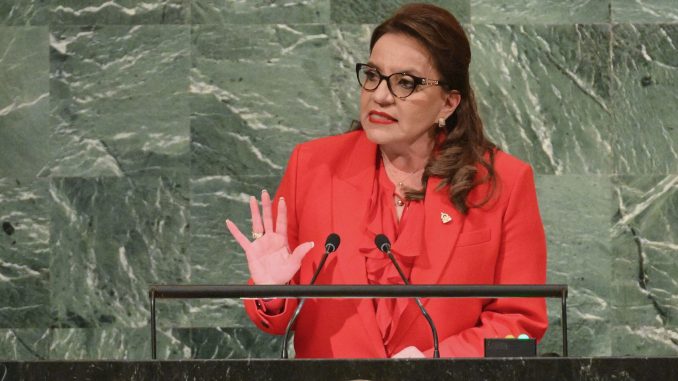
Honduras on March 15 announced plans to establish diplomatic relations with the People’s Republic of China.
Given Beijing’s insistence on a “One China Principle,” the move will require the Central American nation to cut ties with Taiwan, leaving the island with just 13 formal diplomatic partners. This represents not only a blow to Taipei’s international status, but a victory for China in America’s backyard.
Honduras is hardly the first country in recent years to ditch Taiwan in exchange for alluring promises of enhanced trade and investment ties with the world’s second-largest economy.
When the move becomes official, it will be the ninth country to sever relations with Taiwan since Tsai Ing-wen became the island’s president in 2016. Five of those nine are in the Western Hemisphere.
Beijing views poaching Taiwan’s diplomatic partners as an effective way to discredit the leadership of Tsai and her Democratic Progressive Party. China’s leaders distrust the party and would prefer to deal with a president from the opposition Kuomintang, which despite being a historical enemy of the Chinese Communist Party, has its own version of the “One China Principle” and takes a less confrontational approach to relations with Beijing.
With Taiwan’s next election just 10 months away, Beijing could seek to entice another country to cut ties with the island in the months ahead.
In concrete terms, the impact of this development on Taiwan’s security and international standing is limited. Honduras can do little to protect Taiwan from Chinese military action or magnify Taipei’s diplomatic clout.
The same goes for Paraguay, Haiti, and the rest of the small, mostly developing countries that recognize Taiwan’s sovereignty. Its most consequential support comes from unofficial relationships with global powers, such as the U.S., Japan, Australia, and many European nations. These unofficial relationships have flourished in the seven years since Tsai took office.
But Taiwan’s official diplomatic relations play a symbolically important role that shouldn’t be ignored. That there are still countries that officially recognize Taipei weakens Beijing’s claim over the island and gives Taiwan’s sovereignty a small degree of legal backing.
If all of Taiwan’s diplomatic partners eventually jump ship, Beijing’s oft-cited line that Taiwan is universally recognized as a part of China will technically be true.
It’s in America’s interest to help Taiwan preserve its diplomatic relations. Washington can only engage Taipei unofficially: Countless official statements from Beijing indicate that it would likely respond to any U.S. diplomatic recognition of Taiwan with military force, and given the stakes, neither of Taiwan’s main political parties would support recognition.
While the consequences wouldn’t be so dire if a few small developing states switched recognition to Taiwan, as reports indicate Micronesia is considering doing, the chance of sufficient numbers of countries doing so to offset Beijing’s poaching is very low, given the economic and political punishments Beijing would surely deploy against countries that did so.
The only effective way to help Taiwan maintain a degree of formal recognition is to help it preserve the diplomatic partners it currently has.
Little can be done in the case of Honduras. Even if last-minute diplomacy manages to buy some time, recognition of China was one of Honduran President Xiomara Castro’s campaign pledges. The same pressures that led to Castro’s decision exist for many of Taiwan’s diplomatic partners, and though most of them do not appear to be actively considering abandoning Taipei, in some cases change could be only an election away.
Once a decision to recognize China is made, it’s very hard for Washington to persuade a country to change its mind. At that point, diplomatic overtures tend to ring hollow, especially coming from a country that cut ties with Taiwan to recognize Beijing decades ago.
These developing countries have economic and political needs that require the active presence of a world-class power—a role China is happy to play. While Taiwan is able to give its partners loans and other kinds of aid, China provides the infrastructure investment, export markets, and political support in international organizations that these countries require to meet their development needs.
These governments often distrust China, but with major development obligations, they feel they have little choice but to turn to Beijing.
If Washington wants to support Taiwan, the first thing it should do is reengage with the developing world, and especially with countries that currently recognize Taipei. Only by helping to meet these countries’ investment, infrastructure, and trade needs can America fill the gaps that push many countries to elect leaders that will pivot to China.
With all the talk in the U.S. of “friendshoring” and “nearshoring” supply chains away from China, there should be no shortage of opportunities.
Of particular importance is the Western Hemisphere. Since the Monroe Doctrine was announced 200 years ago, this hemisphere has, at least in principle, been exclusively in America’s sphere of influence. But decades of neglect have opened the door for America’s chief geopolitical adversary to make inroads.
China is already the top trading partner of several countries in the hemisphere and is becoming increasingly active in infrastructure investments.
By increasing trade and investment in the Western Hemisphere, the U.S. can not only fight to preserve its influence from Beijing’s encroachment. It can also help Taiwan hold onto its diplomatic partners, more than half of them located in the hemisphere.
Indeed, U.S. engagement in the Western Hemisphere has never been more crucial both for preserving America’s leadership and for securing Taiwan’s international status.
Have an opinion about this article? To sound off, please email letters@DailySignal.com and we’ll consider publishing your edited remarks in our regular “We Hear You” feature. Remember to include the url or headline of the article plus your name and town and/or state.

